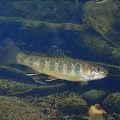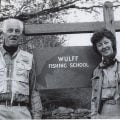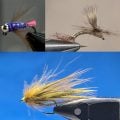How to Tie a Conehead Bunny Muddler
Producer: Tim Flagler
The Conehead Bunny Muddler is a versatile streamer pattern that has proven itself effective on trout, bass and pike. The rabbit zonker tail and back have a ton of motion while the deer hair collar pushes water and really makes the fly’s presence known. Add just a bit of flash and some rubber legs, and you have a fly that not only gets the job done but is also fun to fish.
The Conehead Bunny Muddler starts with a size 4 Mustad 9672 hook. You can absolutely go larger if you’d like. The size 4 hook is paired with a size large tungsten nickel-colored conehead. Work the cone on to the hook and around the bend. Sometimes you have to mash the barb to make this happen. Then, get the assembly firmly secured in the jaws of your tying vise.
.02 lead-free wire is used to add a bit more weight and to help stabilize the cone on the hook. Pick up the spool and get hold of the wire’s bitter end in the fingertips of your left hand. Start taking wraps around the hook shank with your right. After 20 or so, helicopter the wire to break it off close. Make sure the wraps are able to move on the shank.
Get hold of some superglue, here Fly Tyer’s Z-Ment, and apply an ample drop to the hook shank behind the cone. Quickly slide the wraps forward, up into the cone, and hold them there. The pressure will cause the adhesive to set, locking everything in tight behind the hook eye. The tag end of the wire can then be easily wrapped without everything spinning on the shank.
Because of the deer hair collar on the fly, I like to use gel spun 130 Denier thread in white, but 140 Denier regular nylon thread will also work just fine. Get the thread started on the hook shank behind the wire wraps and, after taking a few wraps rearward, snip or cut off the excess tag. Continue taking thread wraps to further anchor the wire. End with your thread behind the wire. Although not absolutely necessary, a drop of superglue applied to the wire and thread wraps at this point will further lock everything in place on the hook shank.
Pull free from the hank and snip off 3 or 4 strands of pearl Krystal Flash. Lay the midpoint of the strands on top of the hook shank at the location of your tying thread, and take tight wraps to secure it. Pull the forward-pointing portion back and lock it down to double the number of strands. Then, bind them to the top of the hook shank with tight wraps of tying thread, all the way back to the start of the hook bend.
Black, zonked rabbit is used to form the tail and back of the fly. With the fur canted rearward, measure a hook-long length of hide and transfer that measurement rearward to the start of the hook bend. Separate the rabbit fur at this point and take two thread wraps to secure it. Pull the strip back and take two more around just the shank, followed by two more over top of the hide.
For additional security, I like to add a drop of head cement or here, Sally Hansen Hard as Nails, to the thread wraps at the tie-down point. Pull the rabbit zonker strip back and out of the way then advance your tying thread forward, up the hook shank to immediately behind the conehead.
Snip free a 4-card-width length of silver sparkle braid. Begin securing one end of the braid to the top of the hook shank at the back edge of the cone then bind it down all the way to the base of the tail. End with your tying thread a hook-eye length back from the back edge of the cone. Start taking overlapping wraps with the sparkle braid to build up a flashy little body on the fly. When you reach your tying thread, use it to anchor the braid then snip the excess off close. Take a few more thread wraps to cover up any straggly ends.
Snip free from the hank 8-10 red Krystal Flash fibers and find their midpoint. Lay the midpoint against the near side of the hook and take thread wraps to secure it. Pull the forward-pointing portion of the material over to the far side of the hook and secure it there. Ideally you want the flash angled down and back, beard-style. Snip the flash off so it extends just past the hook point. The fly should now look something like this.
Black and red Flake Crazy Legs are used to add even more flash and motion to the fly. Pull or snip free two strands and affix their midpoint to the near side of the hook with wraps of tying thread. Pull the forward-pointing portion of the Crazy Legs over to the far side of the hook and secure them there. Snip the Crazy Legs off so they extend a little ways past the hook bend. Take wraps of tying thread to fill in and level out the area behind the cone.
Pull the Zonker strip forward, out over the hook eye, and create an open spot in the fur above your tying thread. Use the same two, two and two wrap sequence to secure the Zonker strip to the top of the hook shank, then snip the excess off as close as possible. Once again, take thread wraps to level out the tie-down area. Because there are so many materials tied in at this point, a drop of superglue applied to the area behind the cone, followed by thread wraps, will ensure nothing can come unraveled or pull free. Here, too, try to keep this space reasonably level.
Natural-colored Muddler or deer body hair can be used for the collar of the fly. Snip a pencil-width diameter clump free from the hide and, while holding the clump by the tips, pull out any loose, short hairs from the butt ends. Then, with a fine-toothed comb, or here a double-row flea comb, clean out the fine, wispy fibers from the hair. Place the clump, tips first, into a wide-mouth stacker and give it a real good stacking. With the tips pointing toward the rear of the fly, remove the hair from the stacker and get hold of it in the fingers of your right hand.
Measure so the hair tips extend rearward to about the hook barb. While keeping this measurement, pass the clump to the fingers of your left hand. This will allow you to trim the excess butt ends off square with just a little extending past your fingertips. Place the clump on top of the hook shank, like so, and take a thread wrap over top of it. While holding the clump in place, increase thread tension to anchor and flare the deer hair. Take thread wraps forward through the hair until you get to the back edge of the cone. Use the thumb of your right hand to spread the deer hair out on either side of the fly.
Repeat the same deer hair prep as before, resulting in a similar clump. Measure this so it extends the same length rearward as the first. Here too, snip the excess butt ends off prior to tie-in. Place the ends on the underside of the hook and repeat the same tie-in procedure as before. If there are any areas that didn’t quite get filled in, just repeat the same procedure with a smaller clump of hair to fill in that area. Once you have a nice, full collar, work your tying thread up to the back edge of the cone where it should be held fairly snug. Because I’m using gel spun, I like to cut the thread off with a double edge razor blade.
A drop of head cement squirted down into the thread wraps within the cone will ensure the they don’t come unraveled, even without a whip finish. A fresh double edge blade is my tool of choice for cleaning up the short butt ends of deer hair behind the cone. Go slowly, and if you see bare thread, stop trimming immediately. Once completely trimmed, the Conehead Bunny Muddler should look something like this.
Whether swung or retrieved by stripping, this is one super effective streamer pattern.
How to Tie a Conehead Bunny Leech
How to Tie a Corded Cased Caddis











